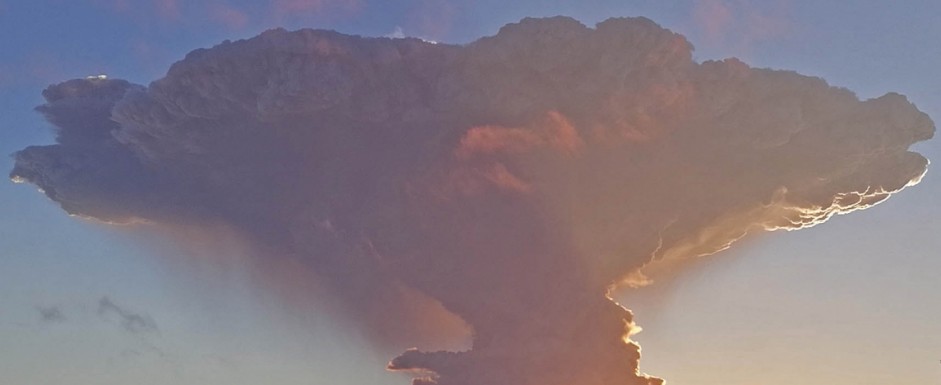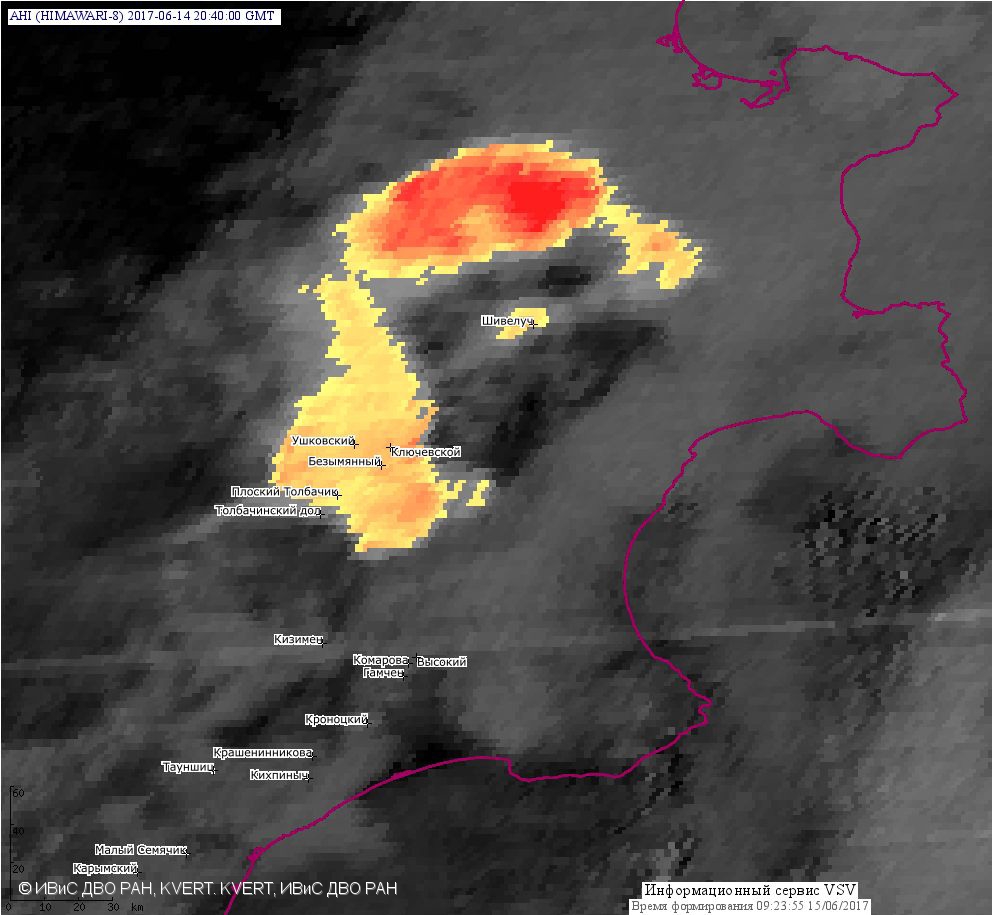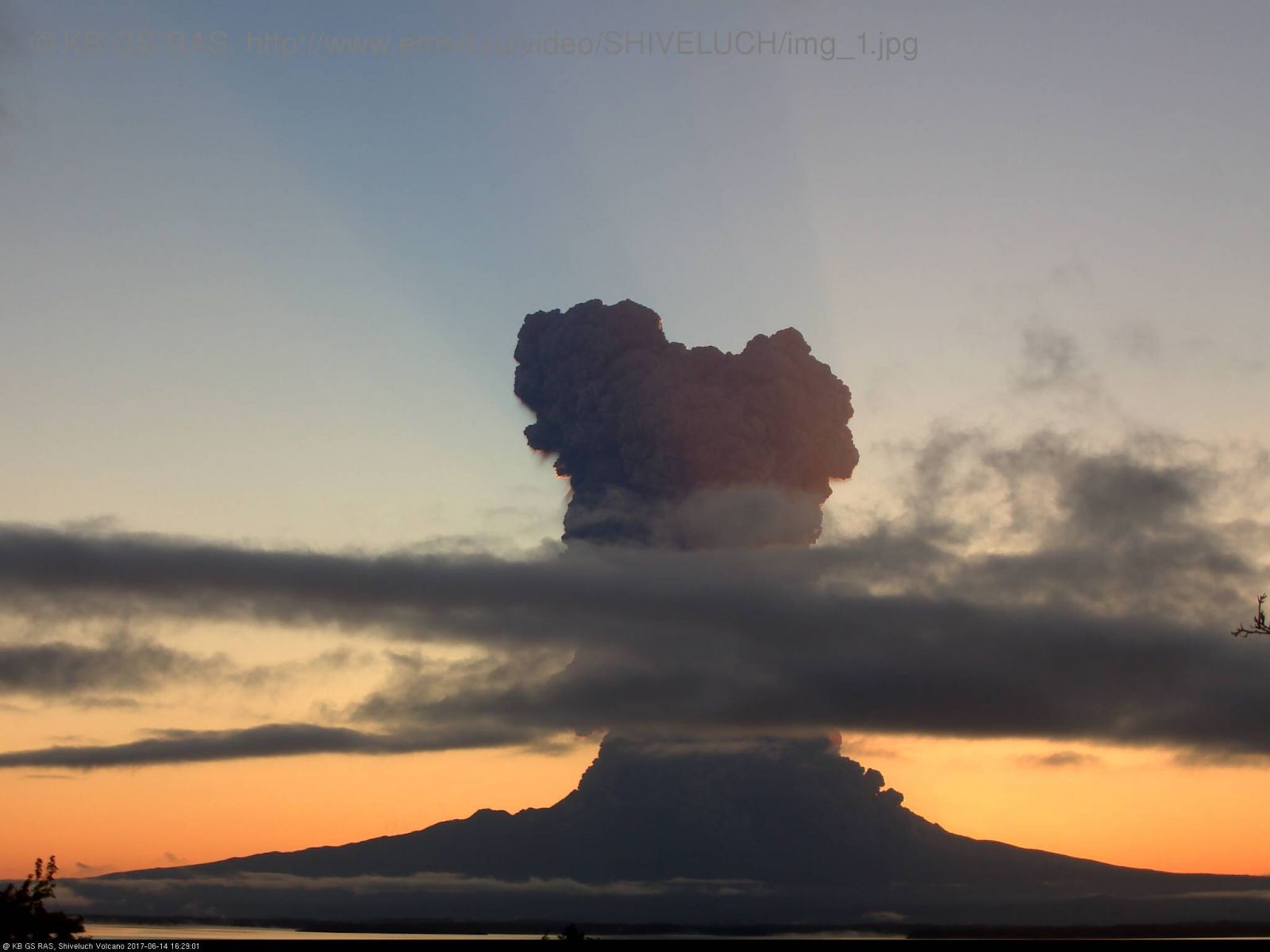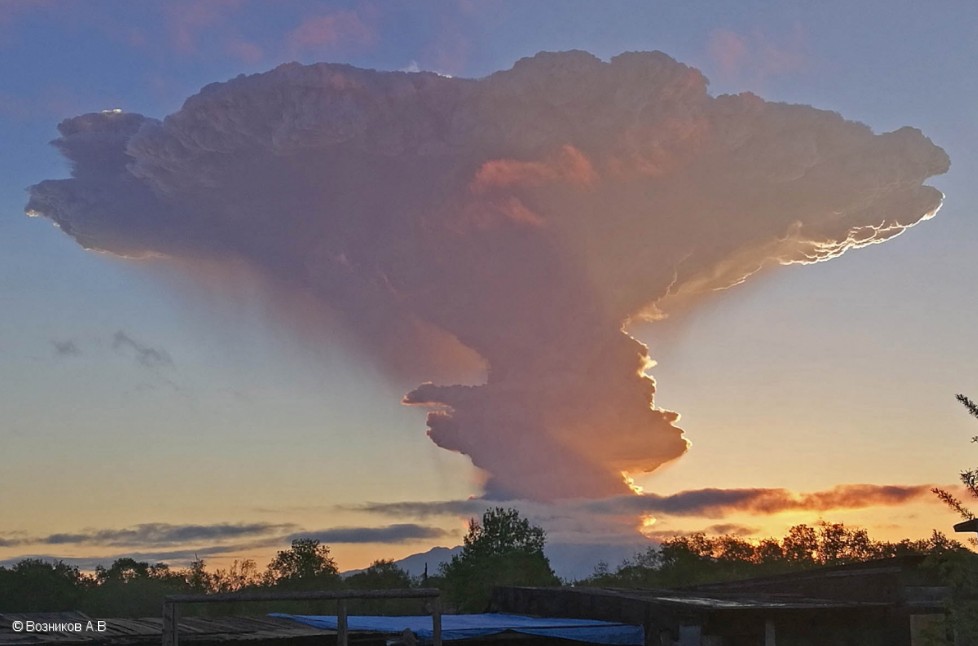Powerful eruption of Sheveluch volcano sends ash to 12 km (39 360 feet) a.s.l.

A major eruption started at Russia's Sheveluch volcano at 16:20 UTC on June 14, 2017. KVERT reports a plume of ash reached a height of 12 km (39 360 feet) above sea level and warned explosions up to 15 km (49 200 feet) could occur at any time. The Aviation Color Code was raised from Orange to Red.
At 19:00 UTC, vast ash cloud (140 x 60 km / 87 x 37 miles) from the eruption was observed about 64 km (40 miles) to the southwest and 76 km (47 miles) to the northwest from the volcano, KVERT said at 19:32 UTC. By 20:20 UTC, ash cloud grew to 196 x 223 km (122 x 138 miles). Front of ash cloud with a large content of ash particles (67 x 54 km / 41 x 33 miles) was observed about 96 km (59 miles) north-northwest of the volcano, but the other front of ash cloud was 118 km (73 miles) southwest of the volcano.

Ash cloud at 20:40 UTC on June 14, 2017. A large content of ash particles is noted in red color. Credit: KVERT, IVS FEB RAS
By 22:30 UTC, ash cloud grew to 422 x 155 km (262 x 96 miles / 36 000 km2 / 13 900 mi2). Ash cloud with a large content of ash particles (84 x 55 km / 52 x 34 miles) was observed 131 km (81 miles) to the north-northeast. A general front of the largest ash cloud was observed 225 km (140 miles) to the northeast, and the other about 194 km (120 miles) to the southwest. By 06:00 UTC, the front of first ash plume was about 640 km (398 miles) to the ENE of the volcano, while the front of the second ash plume was about 294 km (182 miles) SW.

Sheveluch erupting at 16:29 UTC on June 14, 2017. Credit: KB GS RAS

Huge ash plume above Sheveluch volcano around 23:30 UTC on June 14, 2017. Credit: Voznikov A.V.
At 06:56 UTC on June 14, KVERT said that explosive-extrusive eruption of the volcano continues and warned that ash explosions up to 10 – 15 km (32 800 – 49 200 feet) above sea could occur at any time. Ongoing activity could affect international and low-flying aircraft.

Animation courtesy JMA/Himawari-8, CIRA
Taking into account the wind direction of ash plume, the city of Klyuchi, located at a distance of 50 km (31 miles) S of the volcano, is expected to be most exposed to dangerous ashfall, EMERCOM said.
"The population was notified by the stationary loudspeakers and were given advice on how to behave during the ashfall," it said, adding that the community has a sufficient number of respirators.
Residents of the districts of Ust-Kamchatsky, located about 85 km (53 miles) SSE of the volcano, and Milkovsky, about 240 km (150 miles) S, were recommended not to go out if they notice ashfall.
Furthermore, the General Directorate of EMERCOM of Russia for Kamchatka region warned the population that inhalation of ash is dangerous and can cause allergic reactions:
- If you notice ashfall, close the doors and windows.
- If the ash enters the home, family members should wear respirators, gauze bandages or breathe trough a towel.
- Cover computers, stereo, and other equipment with plastic wrap or thick cloth and do not use them during ashfall.
- If you were outside during ashfall, do not bring the clothes in the house.
- After the ashfall, wear a dust mask and goggles before cleaning the house from the ashes; clean roof gutters and other places in which ash may have accumulated.
Powerful eruption of the volcano Shiveluch in Kamchatka today (Russia, June 15, 2017). pic.twitter.com/P0QaW5E60C
— #MeteoRussia (@WeatherRUS) June 15, 2017
Geological summary
The high, isolated massif of Sheveluch volcano (also spelled Shiveluch) rises above the lowlands NNE of the Kliuchevskaya volcano group. The 1 300 km3 (311.9 mi3) volcano is one of Kamchatka's largest and most active volcanic structures. The summit of roughly 65 000-year-old Stary Shiveluch is truncated by a broad 9-km-wide late-Pleistocene (5.6 miles) caldera breached to the south. Many lava domes dot its outer flanks. The Molodoy Shiveluch lava-dome complex was constructed during the Holocene within the large horseshoe-shaped caldera; Holocene lava dome extrusion also took place on the flanks of Stary Shiveluch.
At least 60 large eruptions have occurred during the Holocene, making it the most vigorous andesitic volcano of the Kuril-Kamchatka arc. Widespread tephra layers from these eruptions have provided valuable time markers for dating volcanic events in Kamchatka. Frequent collapses of dome complexes, most recently in 1964, have produced debris avalanches whose deposits cover much of the floor of the breached caldera. (GVP)
Featured image: Huge ash plume above Sheveluch volcano around 23:30 UTC on June 14, 2017. Credit: Voznikov A.V.

The obvious is that ash spread into the atmosphere causes cooling by blocking solar radiation from entering to the ground where the contact creates heat from the reaction with it and organics. The question is what are the gaseous contents of the eruptions composition and quantities… Cooling Aerosols v. Greenhouse gases. If there is a balance of CA and GHG then only a cooling from the ash clouds occurs. If there are higher CA then climate will cool somewhat depending upon how much was injected into the atmosphere. If more GHG than CA then it depends upon the quantity that offsets the ash clouds cooling to create warming years later. That scientists are not monitoring these gases as they are being ejected when they occur, by sampling while the eruptions are happening, it is hard to predict the Climate Change it could or isn’t effecting.
And how does this affect climate change?
Mankind can’t control this, can they?